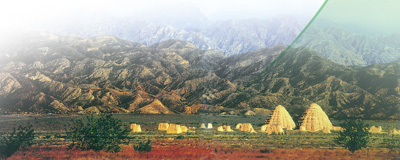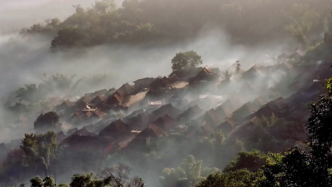
The Paper was informed that at 15:34 local time on September 17 (20:34 Beijing time), at the 45th World Heritage Conference held in Riyadh, the capital of Saudi Arabia, as the chairman of the conference dropped the hammer, China submitted " The "Cultural Landscape of Old Tea Forests of the Jingmai Mountain in Pu'er" project was approved by the World Heritage Committee to be included in the World Cultural Heritage List, becoming China's 57th World Heritage.
After 13 years of application, the "Pu'er Jingmai Mountain Ancient Tea Forest Cultural Landscape" has become the sixth World Heritage in Yunnan Province, filling the gap in the world's tea world cultural heritage. Upon learning of the news that the "Pu'er Jingmai Mountain Ancient Tea Forest Cultural Landscape" was successfully applied for World Heritage status, Wang Jianrong, the former director of the China Tea Museum, said in an interview with The Paper that the core value of the Jingmai Mountain Ancient Tea Forest lies first in its thousand-year-old ancient tea forest. Known as “the origin of tea’s natural underforest cultivation” and “the Museum of Human Tea Culture, History and Nature”, it provides opportunities to study the origin, evolution, artificial domestication and spread of tea trees, as well as to clarify the relationship between the origin of tea tree species and early domestication and cultivation. Real and powerful evidence of a relationship.

The Chinese delegation reviewed the 45th World Heritage Conference held in Riyadh, the capital of Saudi Arabia, on September 17. The Paper.
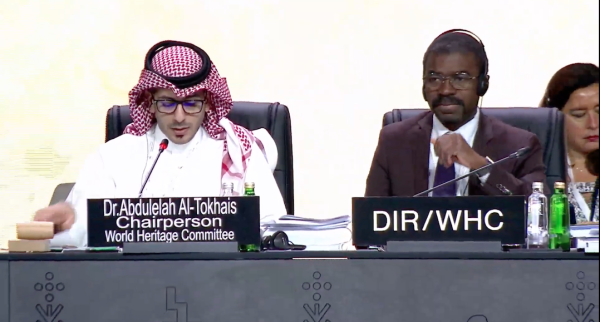
At the 45th World Heritage Conference held in Riyadh, the capital of Saudi Arabia, the moment the "Pu'er Jingmai Mountain Ancient Tea Forest Cultural Landscape" was approved to become a world heritage. The Paper

The scene of the 45th World Heritage Conference Qingyuan Cultural Heritage Photography Wei Qingshangjin

Entrance to Jingmai Mountain Ancient Tea Forest
Shan Jixiang, president of the Chinese Cultural Relics Society and former director of the Palace Museum, previously said that Chinese tea culture has an extremely profound heritage and a long history, and the ancient tea forest in Jingmai Mountain is unique because of its "ancient" and "forest". Compared with other famous terraced and farm-style terrace tea gardens in the world, the ancient tea forest in Jingmai Mountain not only has a longer history, but also has distinctive features in its traditional understory planting methods and maintenance methods that utilize the stability of the forest ecosystem.

On February 25, 2023, Pu'er City, Yunnan Province, aerial photography of Nuogang Ancient Village.
Pu'er Jingmai Mountain Ancient Tea Forest Cultural Landscape is located in Huimin Town, Lancang Lahu Autonomous County, Pu'er City, Yunnan Province, China. It is an evolving cultural landscape composed of ancient tea forests, tea gardens, forests and traditional villages. The land use practices of the Blang and Dai people here can be traced back to the 10th century AD. Based on long-term exploration and practice, the Shiju ethnic group formed a smart forest tea planting technology and passed it down to this day. It is a model of primitive forest agriculture and human tea planting model. The ancient tea forest in Jingmai Mountain embodies the simple ecological ethics and wisdom of harmony between man and earth, which has enlightenment significance for the sustainable development of today's world.

The 45th World Heritage Conference held in Riyadh, the capital of Saudi Arabia
Wang Jianrong said in an interview with The Paper that the core value of the ancient tea forest in Jingmai Mountain lies first in its thousand-year-old ancient tea forest, in the traditional villages where many ethnic groups live together, and in that it is a three-dimensional compound mountainous high-efficiency agriculture and characteristic residential landscape. example. "I firmly believe that the successful application of Jingmai as a World Heritage Site will effectively promote the sustainable development of China's tea industry and greatly enhance the global influence of China's tea industry."
Shan Jixiang previously revealed: "In June 2010, I came to Pu'er City to attend a seminar on the Ancient Tea Horse Road. Several friends showed me photos of the ancient tea forest in Jingmai Mountain. I was shocked by its original ecological appearance. China's Tea culture spreads around the world, but there is still no World Heritage about tea. Can the ancient tea forest in Jingmai Mountain be declared a world heritage? Back in Beijing, I asked Mr. Guo Zhan, the then Vice Chairman of the International Council on Monuments and Sites, to come in person. Jingmai Mountain inspection. After returning from the inspection, Mr. Guo Zhan was particularly excited and believed that the Jingmai Mountain Ancient Tea Forest fully met the criteria for applying for a world heritage. The application for the Jingmai Mountain Ancient Tea Forest was officially launched. In the following more than ten years, The Jingmai Mountain Ancient Tea Forest Heritage Site has done a lot of work in terms of value recognition and heritage protection around the application process, and has achieved a lot of results. "
Looking back at the road to the application of the ancient tea forest cultural landscape of Jingmai Mountain in Pu'er, it has gone through 13 years. In 2010, the application process for the ancient tea forest cultural landscape of Pu'er Jingmai Mountain was fully launched. This project was included in the preliminary list in 2013 and is an application project submitted by China in 2021. It completed the ICOMOS on-site inspection in 2022 and was "recommended for inclusion" by the consulting agency. It has the potential to meet the OUV value standard (iii) (v). It was approved to be included in the World Heritage List at the 45th World Heritage Conference held in Riyadh, the capital of Saudi Arabia in 2023.
Jingmai Mountain Ancient Tea Forest Cultural Landscape
The Jingmai Mountain Ancient Tea Forest Cultural Landscape Heritage Area covers an area of 7167.89 hectares and a buffer zone of 11927.85 hectares. The heritage elements include 5 ancient tea forests, 3 separated protective forests and 9 traditional villages.

Jingmai Mountain in Pu'er, Yunnan
Jingmai Mountain is located in Lancang Lahu Autonomous County, Pu'er City, Yunnan Province, China, among the mountains formed by the remnants of the Nu Mountains in southwest Yunnan, and is surrounded on three sides by Nanmen River and Nanlang River, tributaries of the Lancang River. The Dai and Bulang ethnic groups who live in Jingmai Mountain discovered wild tea trees in the original forest of Jingmai Mountain. Through artificial domestication and cultivation, and after a long period of continuous efforts and development, a total of 1230.63 hectares of ancient tea trees were formed from an altitude of 1250 meters to the top of the mountain. There is a forest protection belt about 40 meters wide around the tea forest and tea forest. The village is located in a tea forest and is built along the mountain. The altitude is between 1,280 and 1,500 meters. At lower altitudes, there are ecological tea gardens, cultivated land and woodland, forming a vertical land use method of agroforestry. As an organically evolving cultural landscape, the traditional "tea planting method under the forest" that continues to this day is a living example of early human utilization of tea trees. The landscape pattern of "mountains share forests, forests grow tea, tea surrounds villages, and people raise tea" carries the It has a thousand-year history of "symbiosis of forests and tea, and co-prosperity of man and earth".
Magical ancient tea forest
Ancient tea forests are mainly distributed in forests between 1,250 and 1,550 meters above sea level, around villages. They have a long history of more than a thousand years and are well preserved to this day. The ancestors reclaimed the forest and planted tea under the woods, retaining the biodiversity of the tea to the maximum extent, thus ensuring that no fertilizers or pesticides were used, which reflected superb ecological wisdom. The ancient tea forest is still full of vitality.

Dapingzhang Ancient Tea Forest in Jingmai Village
The ancient tea forest was gradually cultivated by the ancestors of the Bulang and Dai peoples in their production and life practices for thousands of years. Since cultivated Pu'er tea trees gradually enter a period of low yield and decline after a certain age (about 100 years), there is a dynamic process of renewal and succession in ancient tea forests.
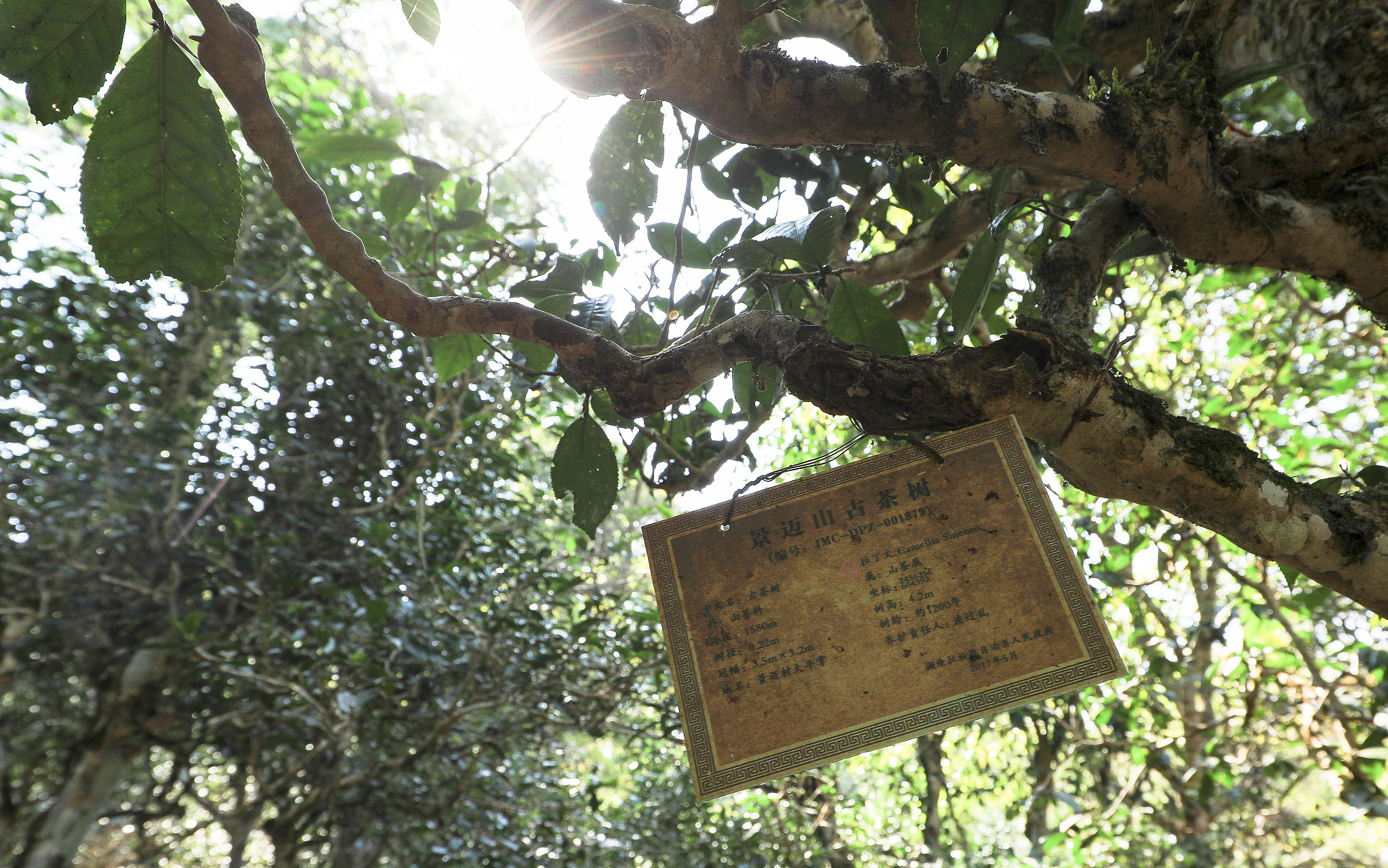
Ancient tree tea in Jingmai Mountain
The ancient tea forest in Jingmai Mountain adopts unique inter-forest and under-forest planting techniques.
In order to effectively prevent natural disasters such as strong winds, frost, and the spread of pests and diseases, the ancestors of Jingmai Mountain chose to develop ancient tea forests in limited patches among the forests. On the one hand, they control the tea garden reclamation area around the village, and on the other hand, they retain the forest protection line around the reclaimed ancient tea forest, which is a virgin forest belt that is prohibited from logging. It is about 40 meters wide and surrounds the tea forest. The Blang people call it "back". ". A certain area of forest will be reserved between villages as a separation boundary. Not only can trees not be cut down, but tea cannot be grown within the boundaries.

Entering the tea-picking period, people pick tea in the ancient tea forests of Jingmai Mountain.
Yunnan big-leaf tea is a crop that tolerates shade, loves temperature and humidity. When the light intensity reaches about 80%, the tea tree reaches its best growth state and maximum yield. The ancestors of Jingmai Mountain gradually realized the growth habits of tea trees, simulated and utilized the forest ecological environment, cut down some trees and shrubs in the natural forest and retained certain shade trees, then planted tea trees and maintained the tea gardens. This ancient and special understory planting technology makes the ancient tea forest show an obvious three-dimensional community structure of the tree layer - the shrub layer (the main distribution layer of tea trees) - the upper - middle - lower herb layer.
The unique planting methods in the forest and under the forest make the ancient tea forest in Jingmai Mountain have rich biodiversity that is very similar to the natural forest. The number of species, richness index, diversity index and evenness index of ancient tea forests are very similar to those of natural forests, and are significantly higher than those of modern tea gardens where the forest appearance is relatively monotonous.
In the "Four Centers" exhibition hall of Jingmai Mountain's ancient tea forest cultural landscape application, biodiversity is fully presented: 14 species of my country's key protected wild plants such as Cycad cycad, cypress, red toon, golden buckwheat and other wild plants coexist with tea trees. There are countless animals.
On the one hand, good plant and animal diversity enables species to form a mutually restrictive relationship, which can effectively suppress the occurrence of pests and diseases. At the same time, the fallen leaves of the upper trees provide rich organic nutrients for the growth of tea trees, thus effectively maintaining the ancient tea forest ecosystem. of stability.
harmonious ancient village
Traditional villages have a very long history. The ancestors of the Bulang ethnic group migrated here from present-day Ruili and the Wa State of Myanmar during the Tang Dynasty in the 7th century AD, and then the ancestors of the Dai ethnic group also came all the way from the present-day Ruili area. They settled in Jingmai Mountain, grew tea for a living, communicated with each other, lived in harmony, and jointly built a beautiful tea mountain home.
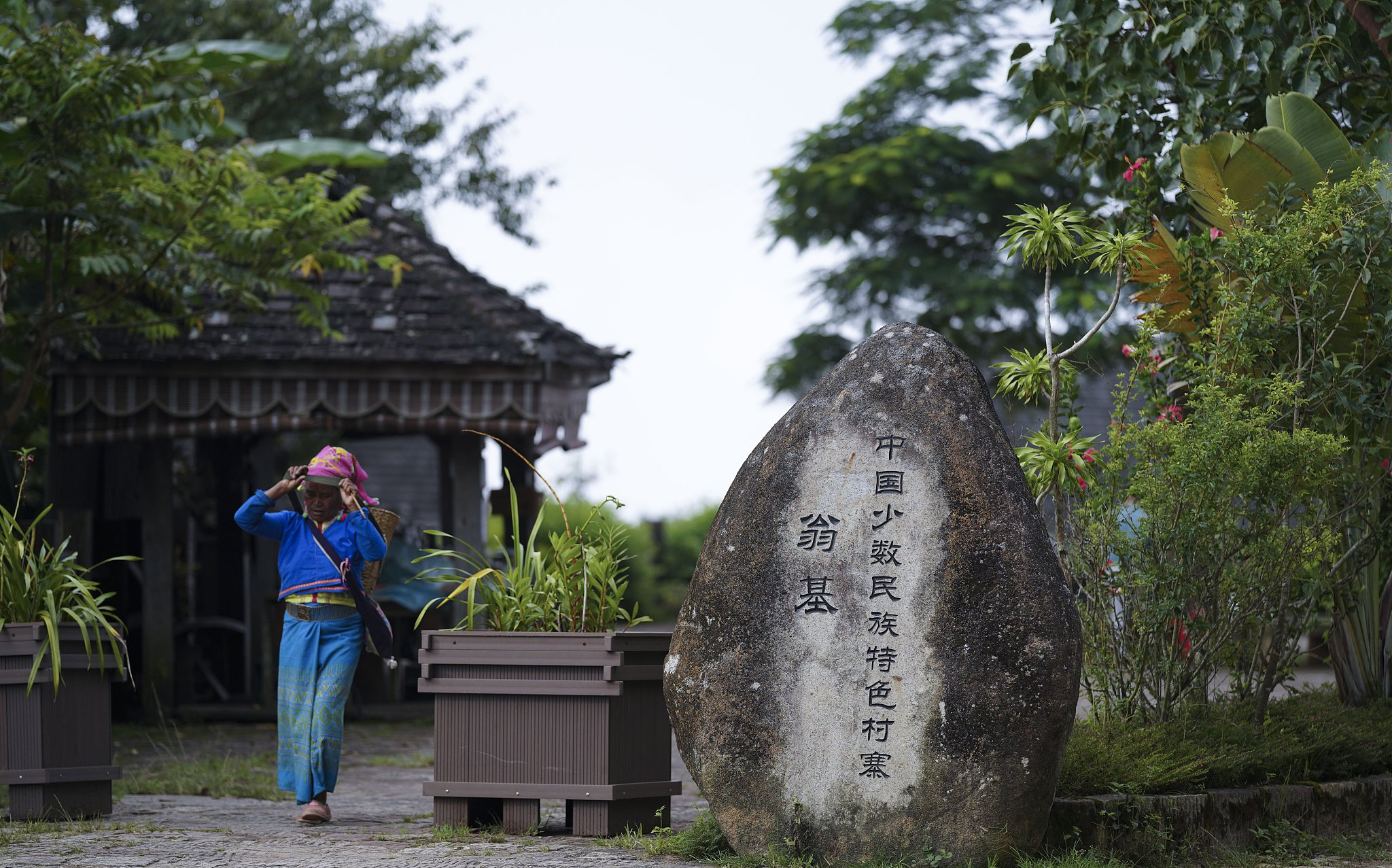
On September 22, 2022, a villager of the Bulang ethnic group in Wengji went to the tea mountain to pick tea.
The declared heritage area includes two administrative villages: Jingmai Village in the Baixiang Mountains in the north and Mangjing Village in the Mangjing Mountains in the south. The former includes four Dai villages including Manggeng, Mengben, Jingmai Dazhai and Nuogang, while the latter includes five Blang villages including Wengji, Mangjingshangzhai, Mangjingxiazhai, Manghong and Wengwa. Among all types of buildings, the proportion of traditional buildings is as high as over 40%.

February 25, 2023, Lancang Nuogang Ancient Village, Pu'er City, Yunnan Province.
The ancestors of the Bulang and Dai people have a common principle in selecting the location of their villages, that is, they should be built according to the mountains, with both sacred mountains and tea mountains. They are all products of a high degree of combination of nature and culture.
Both the Bulang and Dai villages are laid out centripetally with the center of the village as the center, which reflects the cohesion of religion on the village. Built around the sacred mountain. The sacred mountain is not only a sacred place for religious worship, but also the water source forest for the village. The ancestors of the Bulang and Dai people built villages around the sacred mountain in a place with a mountain and water, a gentle slope, good land conditions, and suitable for planting tea trees. Built around tea mountains. Tea is grown wherever the ancestors settled in the heritage area. Their villages are inseparable from the tea forests. In particular, the Blang people are more dependent on the ancient tea forests. Almost all the villages of the Dai and Blang people are embedded in the tea forests. of.
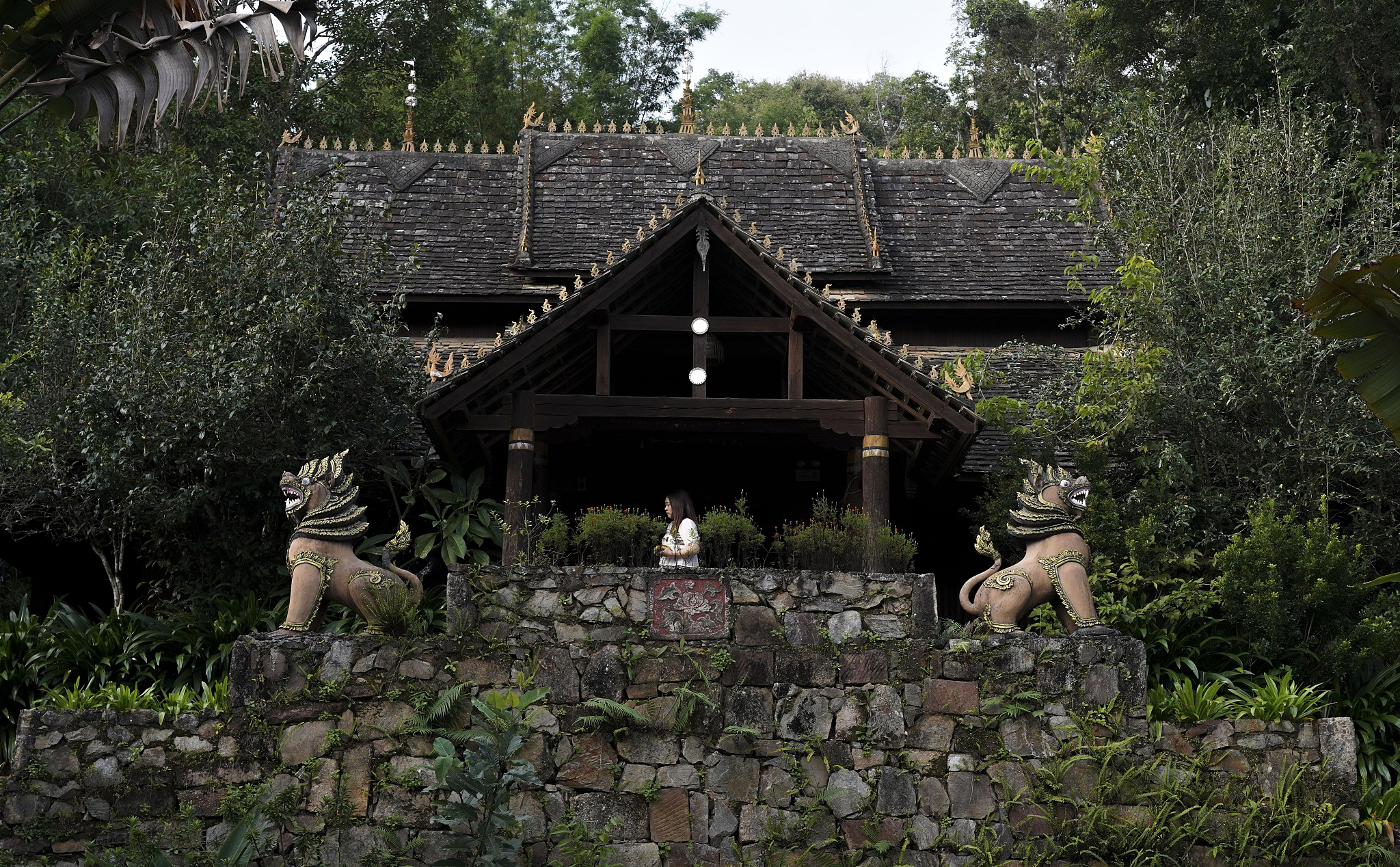
On September 21, 2022, in Pu'er City, Yunnan Province, a tourist visited Wengji Buddhist Temple in Nuogang Ancient Village.
There is usually a "Buddhist temple" building at the entrance of the village, and the central area is the heart of the village. Outside the village, at a certain distance and at a higher altitude, there are the village's Feng Shui Forest and Faith Forest (Dragon Forest). Out of respect for the gods, the internal buildings and streets of the village are basically arranged in a centripetal pattern around the center of the village. The village forms the "heart of the village" from the inside to the outside - centripetal architectural streets - entrance "Buddhist temple" buildings - ancient tea groves and forests (natural worship of the tea god) - Fengshui forest (worship of the natural mountain god), which reflects the belief system spatial layout characteristics.
Shan Jixiang, the former director of the Palace Museum, also recorded what he saw and heard while walking in the ancient tea forest of Jingmai Mountain in his recently published book "Walking Alone for Ten Thousand Miles", which details the two tea forests of Nuogang and Wengji. The ecology of traditional villages.
Among these traditional villages, Nuogang is the most completely preserved and an important embodiment of the harmonious coexistence between man and nature. "Nuogang" means "the place where deer drink water" in Dai language. It is said that groups of deer often come here to drink water, hence the name of the village. Currently, 79 traditional houses in the village have become nationally protected traditional houses.

Nuogang residence (the roof is decorated with buffalo horns)
In Nuogang, we felt the scene of residents carrying out tea planting and production activities in traditional villages. The entire village is divided into the old village with independent space and the new village built in 2000. The village roads follow the terrain and curve up and down, forming a vivid and changeable lane space, with streams passing through the village.
In Jingmai Mountain, the traditional stilt-style residential system has been continuously improved and improved by people who have lived here for generations in order to adapt to the humid and rainy climate in the mountains and rationally utilize the land in the mountains. This fully demonstrates the wisdom of the people who have lived here for generations.

Wengji Residential House (the roof is decorated with "one bud and two leaves")
... Wengji is a typical Blang village, with its roof decorated with "one bud and two leaves". These decorations evolved from architectural components. Because the early stilt-style buildings had thatched roofs, the roofs were supported by two sets of crossed rafters. After the ropes were tied tightly, a section was always left, which was later changed to decoration. The decoration of buffalo horns and "one bud and two leaves" has become the architectural language of the totems of the two ethnic groups, and it also integrates the tea culture, which is quite distinctive.
Rich tea culture
In the long historical life of Pu'er Jingmai Mountain, the ethnic minorities have been accompanied by tea and relied on tea for a living. They have formed a unique cultural landscape in which forests and tea grow together and people and land prosper together, and derived from tea planting, tea picking, tea eating, etc. The extremely rich tea culture of making tea, drinking tea, and tasting tea has distinct regional characteristics and strong national characteristics.

On September 22, 2022, Pu'er City, Yunnan Province, an old man of the Bulang ethnic group in Nuogang Ancient Village.
Tea is vividly reflected in the traditional diet, folk customs, residential decoration, weddings and funerals, and religious worship in Jingmai Mountain, and has a profound impact on the values and production and life of the residents of the world.

Pu'er, Yunnan, Nuogang Ancient Village on Jingmai Mountain in the sunset.
outstanding heritage value
It has taken 13 years for the ancient tea forest cultural landscape of Jingmai Mountain to be applied for World Heritage status. This project was included in the preliminary list in 2013 and is an application project submitted by China in 2021. It completed an ICOMOS on-site inspection in 2022 and obtained the ICOMOS evaluation results that it was recommended to be included without reservation in compliance with standards (iii) and (v).

Ancient trees in the Jingmai Mountain Ancient Tree Tea Garden
Criterion (iii): The ancient tea forest cultural landscape of Jingmai Mountain in Pu'er is an outstanding witness to the tradition of tea tree planting under the forest. This planting tradition allows different land uses to be spatially complementary, providing an ecosystem and microclimate that supports the cultivation of ancient tea forests and the well-being of the communities that inhabit this organically evolving cultural landscape. The Bulang and Dai people have maintained these traditions for thousands of years by practicing the trinity social governance system of "tribe-government-religion". This governance system is built on the belief of the tea ancestors, protecting natural resources and preserving ancient tea forests. Traditional practices take seriously conditions such as mountain climate, topographic features and native flora and fauna, embodying important local and traditional knowledge for the conservation of cultural and biological diversity.
Standard Huai (v): Pu'er Jingmai Mountain Ancient Tea Forest Cultural Landscape is an outstanding example of a sustainable land use system based on combining horizontal and vertical land use methods. This land use system enables complementary uses of natural resources in the mountainous environment of the Jingmai Mountains and is an outstanding example of the interaction of the Blang and Dai people with a challenging environment vulnerable to the negative impacts of modernization, urban development, and climate change. The location and layout of the traditional villages and the style of the houses reflect the culture and traditional knowledge of the Bulang and Dai people.
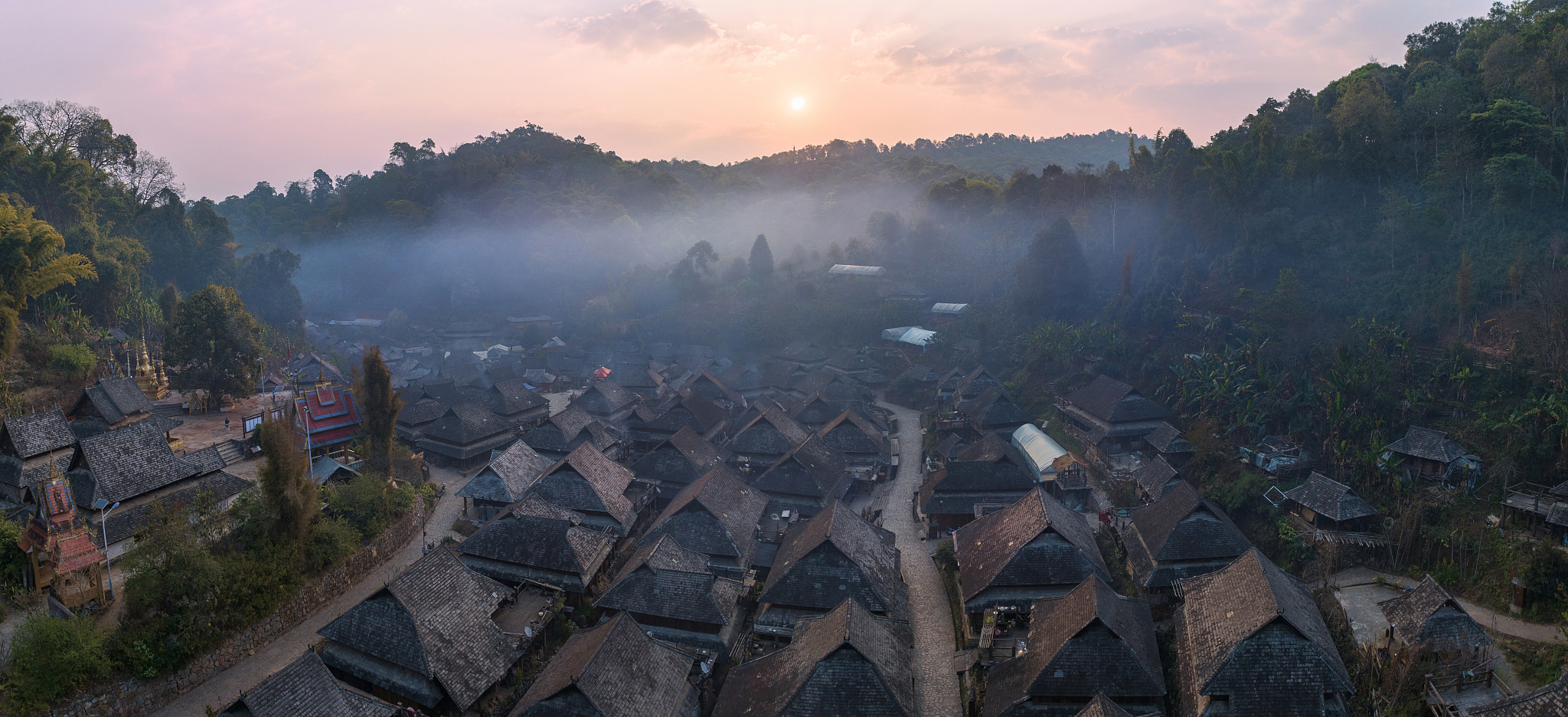
On February 25, 2023, Pu'er City, Yunnan Province, overlooking Nuogang Ancient Village.
Distinguished professor Fan Jianhua of Central China Normal University and his doctoral student Deng Zixuan mentioned in the article "The Value Implications and Significance of the Ancient Tea Forest Cultural Landscape of Jingmai Mountain" that Jingmai Mountain has been in the process of organic evolution from the past to the present. Its history and culture have not been interrupted, the main ethnic group has not changed, the location of the ancient tea forest and tea tree varieties have not changed, every historical stage of the development of the tea industry and traditional residential buildings, and the utilization of tea tree resources by the indigenous groups has a complete picture here. Examples of material culture and intangible culture, it is these real and vivid humanistic imprints and unique geographical advantages that create the diverse cultural heritage value of Jingmai Mountain. Value identification is the core essence of cultural landscape heritage identification. The ancient tea forest cultural landscape of Jingmai Mountain complies with standards iii and v in the World Heritage Outstanding Universal Value (OUV value) evaluation standards. In the long history, the landscape content of Jingmai Mountain has continued to undergo dynamic evolution, and the landscape value has also been continuously extended and deposited. Comprehensively and accurately clarifying the heritage value of the ancient tea forest cultural landscape of Jingmai Mountain is not only an effective way to deeply interpret the outstanding universal value of the heritage, but also to achieve long-term, orderly protection and sustainability of the heritage site after the successful application. development reality.
[Part of the content of this article refers to the "Yunnan Pu'er Jingmai Mountain Ancient Tea Forest Application Brochure", "The Value and Implications of the Jingmai Mountain Ancient Tea Forest Cultural Landscape and the Application Significance" (authors Fan Jianhua and Deng Zixuan) and other related contents]
